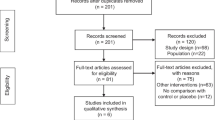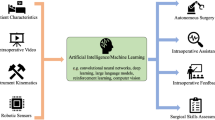Abstract
Background
This study takes an initial step towards understanding the learning process of flexible endoscopic surgery. Bimanual coordination learning curves were contrasted between three different surgical paradigms. We hypothesized that use of an open or laparoscopic paradigm would result in better performance and a shorter learning process (reaching a learning plateau earlier) than an endoscopic paradigm.
Methods
Our model required seven subjects to perform identical bimanual coordination tasks with three different tools (a dual-channel endoscope with graspers, laparoscopic Maryland graspers, and straight hemostats for open surgery). The task required subjects to coordinate two instruments in order to perform a series of standardized maneuvers. Performance was measured by movement speed and accuracy. The learning process was broken down into three distinct phases: the practice phase, the short-term retention phase, and the long-term retention phase. The learning curves of four surgical novices for 33 tasks with each device were compared with the performance of three surgeons.
Results
Overall performance speed was significantly faster using open or laparoscopic tools than endoscopy for all groups (open 13 ± 1 s; lap 28 ± 3 s; endo 202 ± 82 s; P < 0.001). The difference between open and laparoscopy was not significant (P = 0.149). There was no significant difference (P = 0.434) in accuracy (number of ring drops) between any of the devices. Novices performed significantly slower than the expert in the endoscopy task (P = 0.010). Their performance improved with practice (P = 0.005) but they failed to reach the level of the expert after the practice phase (novices: 202.3 ± 23.4 s versus expert: 89.0 ± 34 s, P = 0.009).
Conclusions
Bimanual coordination tasks have shortest performance time and are easiest to learn using an open surgery paradigm. Performance times and the learning process take longer for the laparoscopic paradigm and significantly longer for the endoscopic paradigm.







Similar content being viewed by others
References
ASGE/SAGES Working Group on Natural Orifice Translumenal Endoscopic Surgery (2006) White Paper October 2005. Gastrointest Endosc 63(2):199–203
Peters JH, Ellison EC, Innes JT et al (1991) Safety and efficacy of laparoscopic cholecystectomy. A prospective analysis of 100 initial patients. Ann Surg 213(1):3–12
Spaun GO, Zheng B, Martinec D, Cassera MV, Dunst CM, Swanstrom LL (2009) Bimanual coordination in NOTES: comparing conventional dual channel endoscope, the R-scope and a novel direct drive system. Gastrointest Endosc 69(6):e39–45
Swanstrom L, Zheng B (2008) Spatial orientation and off-axis challenges for NOTES. Gastrointest Endosc Clin North Am 18(2):315–324
Zorron R (2008) NOTES transvaginal cholecystectomy- comperative clinical study with laparoscopy. Digestive Disease Week San Diego, May 20 2008
Spaun GO, Swanstrom LL (2008) Quo vadis NOTES. Eur Surg 40(5):211–219
Oleynikov D (2008) Robotic surgery. Surg Clin North Am 88(5):1121–1130 viii
Stylopoulos N, Rattner D (2003) Robotics and ergonomics. Surg Clin North Am 83(6):1321–1337
Buchmann P, Dincler S (2005) Learning curve–calculation and value in laparoscopic surgery. Ther Umsch 62(2):69–75
Voitk AJ, Tsao SG, Ignatius S (2001) The tail of the learning curve for laparoscopic cholecystectomy. Am J Surg 182(3):250–253
Eden CG, Neill MG, Louie-Johnsun MW (2009) The first 1000 cases of laparoscopic radical prostatectomy in the UK: evidence of multiple ‘learning curves’. BJU Int 103(9):1224–1230
Jowell PS, Baillie J, Branch MS, Affronti J, Browning CL, Bute BP (1996) Quantitative assessment of procedural competence. A prospective study of training in endoscopic retrograde cholangiopancreatography. Ann Intern Med 125(12):983–989
Kowalski T, Kanchana T, Pungpapong S (2003) Perceptions of gastroenterology fellows regarding ERCP competency and training. Gastrointest Endosc 58(3):345–349
Verma D, Gostout CJ, Petersen BT, Levy MJ, Baron TH, Adler DG (2007) Establishing a true assessment of endoscopic competence in ERCP during training and beyond: a single-operator learning curve for deep biliary cannulation in patients with native papillary anatomy. Gastrointest Endosc 65(3):394–400
Vitale GC, Zavaleta CM, Vitale DS, Binford JC, Tran TC, Larson GM (2006) Training surgeons in endoscopic retrograde cholangiopancreatography. Surg Endosc 20(1):149–152
Spaun GO, Zheng B, Swanstrom LL (2009) A multitasking platform for natural orifice translumenal endoscopic surgery (NOTES): a benchtop comparison of a new device for flexible endoscopic surgery and a standard dual-channel endoscope. Surg Endosc. doi:10.1007/s00464-009-0476-5
Acknowledgement
Supported in part by a 2007 NOSCAR research grant.
Disclosures
Dr. G. Spaun’s position at Legacy Health was supported in part by a grant from USGI Medical. Authors B. Zheng, D. Martinec, and B. Arnold have no conflicts of interest or financial ties to disclose. L. Swanstrom receives research support from Olympus, Ethicon Endo Surgery, Boston Scientific, and USGI Medical.
Author information
Authors and Affiliations
Corresponding author
Rights and permissions
About this article
Cite this article
Spaun, G.O., Zheng, B., Martinec, D.V. et al. A comparison of early learning curves for complex bimanual coordination with open, laparoscopic, and flexible endoscopic instrumentation. Surg Endosc 24, 2145–2155 (2010). https://doi.org/10.1007/s00464-010-0913-5
Received:
Accepted:
Published:
Issue Date:
DOI: https://doi.org/10.1007/s00464-010-0913-5




